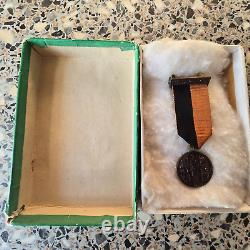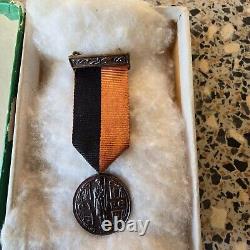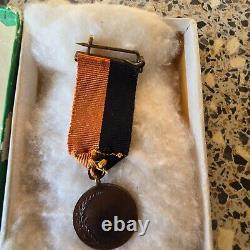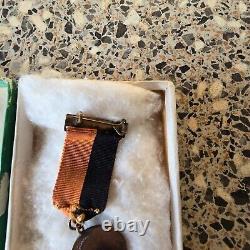
- Home
- Character
- Material
- Bone China (22)
- Brass, Crystal (7)
- Bronze (11)
- Cardboard, Paper (11)
- Ceramic (10)
- Ceramic & Porcelain (11)
- Ceramic, Porcelain (7)
- Crystal (506)
- Crystal, Glass (29)
- Glass (40)
- Gold (13)
- Lace (8)
- Lead Crystal (12)
- Linen (20)
- Metal (12)
- Paper (11)
- Pewter (7)
- Porcelain (104)
- Wood (15)
- Wool (7)
- ... (1189)
- Occasion
- Pattern
- Size
- Subject
Rare Original Irish 1917-1921 Service (black and tan) miniature medal






Medal is 100% genuine, comes as is and no information on the previous owner. I will send it registered. Collection is available, Box not included. Also check out my other auctions. The full size medal was awarded to those who were deemed to have taken part in the Irish War of Independence.
There were two types of medal with Comrac bar issued, named and un-named. Named medals were issued to those Killed in Action or who had died between the end of the war and the issuing of the medals in 1941. There is no difference in design between named and un-named medals.
COMRAC is Gaelic for Struggle. The Irish Volunteers (Irish: Óglaigh na hÉireann), Irish Volunteer Army was a military organisation established in 1913 by Irish nationalists. It was ostensibly formed in response to the formation of the Ulster Volunteers in 1912, and its declared primary aim was "to secure and maintain the rights and liberties common to the whole people of Ireland". The Volunteers included members of the Gaelic League, Ancient Order of Hibernians and Sinn Féin, and, secretly, the Irish Republican Brotherhood (IRB). Increasing rapidly to a strength of nearly 200,000 by mid-1914, it split in September of that year over John Redmond's commitment to the British War effort, with the smaller group retaining the name of "Irish Volunteers". The Irish Volunteers fought for Irish independence in the Easter Rising of 1916, alongside the Irish Citizen Army, Cumann na mBan, and Fianna Éireann. From 1919 it took part in the Irish War of Independence, becoming known as the Irish Republican Army or the IRA. The Easter Rising (Irish: Éirí Amach na Cásca), also known as the Easter Rebellion, was an armed insurrection in Ireland during Easter Week, April 1916. The Rising was launched by Irish republicans to end British rule in Ireland and establish an independent Irish Republic while the United Kingdom was heavily engaged in the First World War. It was the most significant uprising in Ireland since the rebellion of 1798, the first armed action of the Irish revolutionary period. Organised by a seven-man Military Council of the Irish Republican Brotherhood, the Rising began on Easter Monday, 24 April 1916, and lasted for six days. Members of the Irish Volunteers " led by schoolmaster and Irish language activist Patrick Pearse, joined by the smaller Irish Citizen Army of James Connolly and 200 women of Cumann na mBan " seized key locations in Dublin and proclaimed an Irish Republic. The British Army brought in thousands of reinforcements as well as artillery and a gunboat. There was fierce street fighting on the routes into the city centre, where the rebels put up stiff resistance, slowing the British advance and inflicting heavy casualties. Elsewhere in Dublin, the fighting mainly consisted of sniping and long-range gun battles. The main rebel positions were gradually surrounded and bombarded with artillery.There were isolated actions in other parts of Ireland, with attacks on the Royal Irish Constabulary barracks at Ashbourne, County Meath and in County Galway, and the seizure of the town of Enniscorthy, County Wexford. With much greater numbers and heavier weapons, the British Army suppressed the Rising. Pearse agreed to an unconditional surrender on Saturday 29 April, although sporadic fighting continued until Sunday, when word reached the other rebel positions. After the surrender the country remained under martial law. About 3,500 people were taken prisoner by the British, many of whom had played no part in the Rising, and 1,800 of them were sent to internment camps or prisons in Britain.
Most of the leaders of the Rising were executed following courts-martial. The Rising brought physical force republicanism back to the forefront of Irish politics, which for nearly 50 years had been dominated by constitutional nationalism. It, and the British reaction to it, led to increased popular support for Irish independence.
In December 1918, republicans, represented by the reconstituted Sinn Féin party, won a landslide victory in the general election to the British Parliament. They did not take their seats, but instead convened the First Dáil and declared the independence of the Irish Republic, which led to the War of Independence. Almost 500 people were killed in the Easter Rising. About 54% were civilians, 30% were British military and police, and 16% were Irish rebels.
More than 2,600 were wounded. Many of the civilians were killed as a result of the British using artillery and heavy machine guns, or mistaking civilians for rebels. Others were caught in the crossfire in a crowded city. The shelling and the fires it caused left parts of inner city Dublin in ruins.

